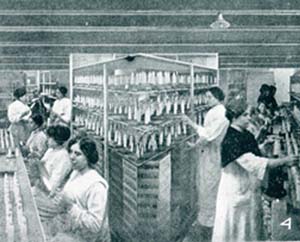
The industrialisation of Catalonia was, to a great extent, made possible by the large amount of female labour available, especially in the textile sector which, as we know, was the most important sector in our country. Women workers were also important in other specialised working fields, such as footwear, printing, metallographics and food preservation. Even so, it is difficult to quantify this work owing to the fact that it was not recorded on voter registers or population censuses. However, the examination of other document sources has revealed high rates of employment of women in a number of different fields of employment in the 19th and 20th centuries. Single women, married women and widows all worked, albeit in different proportions. The percentage of married women in employment depended to a great extent on the number and ages of their children. Women's access to the working world was obstructed by ideology, legislation and the unions (controlled by the workers), especially from the early 20th century onwards because it was widely believed – for different reasons – that a woman's place was in the home, in accordance with the ideas of domesticity and the man as breadwinner.
Cycle: Lectures on the History of Women’s Work in Catalonia, 18th-20th century
Organized by: Residence for Researchers